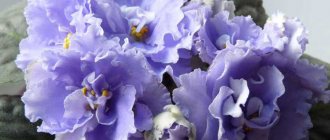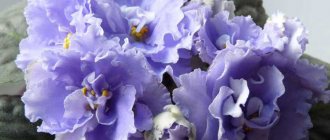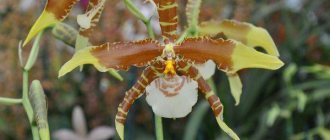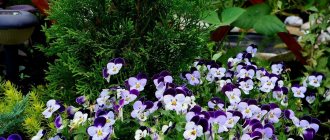Varieties of peonies by color
The color range of peonies is impressive. Through the efforts of breeders, varieties of different tones have been created, with many complex shades. Most of those who are just starting to grow a crop are wondering what colors peonies come in. The color palette starts with a sophisticated white and progresses to dark and black shades. Pink, purple, different shades of yellow and red - rare crops can boast such a variety of colors.
White
Snow-white buds against a background of bright greenery are an impressive and memorable sight. This peony is considered royal; many white varieties confirm this definition:
- Duchess de Nemours. Large flowers up to 20 centimeters in diameter with a lily of the valley scent. It grows up to a meter in height, blooms for about 2 weeks in any weather. The light yellowish tint of the bud in the center turns pearly at the edges.
- Mom's favorite. Peony with dense, dense, double snow-white flowers, petals with a wave along the edge. The bush grows up to 90 centimeters, blooms profusely.
- Moon River. The flowers are white-cream in perfect shape without pistils or stamens. The petals sometimes glow soft pink. A mid-late variety with a stem height of up to 80 centimeters.
- Shirley Temple. White beauty on a dense stem with a spherical head. A very frost-resistant variety (up to -40°) does not need shelter for the winter.
The Festival Maxima is fragrant with the scent of roses. The petals are colored with a red or pink border, which is why the flowers on the bush look different.
Pink
Peonies of various pink shades are among the most popular; many varieties and hybrids have been bred:
- Sarah Bernhardt. An old proven variety with soft pink petals, a flower up to 20 centimeters. The aroma is pronounced, spicy. The bush is durable and does not require garter.
- Nancy Nora. The petals have a delicate and unusual shade of pink and lilac. They do not lose their brightness under the bright sun.
- Monsieur Jules Elie. The spherical flowers are literally filled with bright pink petals. The bush is large, densely strewn with buds.
The Vogue variety blooms with buds with a soft pink tint, which gradually fade into pink-beige. A giant among peonies - when opened, it reaches 25 centimeters.
Red and burgundy
Red peonies impress with their brightness and richness of tone. Many varieties are rare and expensive. Better representatives:
- Henry Boxtos. Pomegranate-colored flowers are distinguished by their large size and splendor. Terry with a pink center, regular shape.
- Team Performance. The diameter of the flower can reach 30 centimeters. When fully expanded, the peony looks like a pompom lying on the smooth lower petals.
- Red. Petals are dark red. Terry, bomb-shaped buds are a true miracle of the garden.
Among burgundy-colored peonies, the most popular varieties are Armani with glossy petals and Peter Brand, which sometimes has 2-3 flowers blooming on the stem.
Tricolor
Breeders have created varieties and hybrids that delight with their multicolored, complex combination of different shades:
- The charm of sunrise. Peony petals are as varied as the color of the sky at sunrise. On the pink base of the lower petals there are narrow cream petals, with crimson streaks appearing in the center.
- Take Sunday apart. A real miracle, like an exquisite dessert, is a combination of different tones of pink and cream.
- Top Brass. A lush flower that combines delicate tones of white, yellow and pink.
The Sherbet (Sorbet) variety has three-layer flowers. The layers are painted white, cream, and soft pink.
Blue and light blue
Some varieties of peonies have the words “blue” or “light blue” in their names. This is rather a dream or a trick of the creators of the hybrid; blue-blue buds have not yet been obtained in reality. Usually the bush blooms with heads of lilac, purple, and pink tones.
Varieties Deep Blue Sea, Blue Doe, Blue Snowflake delight the eye with splendor and beauty, but not with blue shades.
Lilac and purple
The following representatives of lilac and purple peonies enjoy the greatest fame among gardeners:
- Duck Black Ash is a tree-like species with buds of a rich purple-pink hue;
- Bellville is a late-blooming variety with purple and lilac flowers;
- Alexandre Dumas - bred in the 19th century, the color of the petals is lilac-pink, strong aroma;
- Sapphire - lilac petals, corrugated and silky, have purple spots in the center.
See also
Why chrysanthemums sometimes don’t bloom in open ground and how to speed up the process
Read
The varieties Violet Lotus, Lilac Fog, and News of Altai are distinguished by their tenderness and splendor.
Help: It is recommended to frequently moisten the buds of lilac and purple peonies to maintain the brightness of the color.
Yellow
Breeders had to work hard to create yellow peonies; during the blooming process, the shade of the petals often changed to beige or sand. The Lemon Chiffon variety was bred in Holland; bright yellow stamens stand out against a pale lemon background. The color of the petals remains the same throughout the flowering period.
The Golden Willow Peony decorates the garden with unusual yellow-green shades of petals and large spreading bushes. Other famous yellow varieties include Golden Chariot, Sunny Boy, Golden Eagle, Bartzella.
Dark and black
Lovers of dark, almost black flowers should choose the following varieties:
- Black Panther - burgundy-beet heads with a diameter of up to 25 centimeters;
- Black hydrangea - spherical peony heads are painted dark purple, diameter 14 centimeters;
- Sable is a semi-double flower with burgundy petals and a burning golden center;
- Bob is a famous variety with dark purple petals and a bomb-shaped shape.
Gloomy dark beauties are popular among gardeners. Other varieties include Dark Eyes, Black Crown, Sacred Mountain.
Fuchsia and crimson peonies
The color of fuchsia attracts with its brightness, unique chic, and refreshes the greenery of flower beds and summer cottages. The Bouquet Perfect variety looks great, the petals look either crimson or pink-violet.
The lush heads of the Purple Spider variety are cast in purple and fuchsia. The petals are monochromatic, so they look especially bright, the color is saturated. Another miracle of soft magenta tone is Morning Lilac with semi-double, strongly open flowers.
Orange
Orange peonies glow like golden balls in the sun. Among the best varieties:
- Gold scattering - petals of a golden hue with a pink-violet edging;
- Kinkaku Jin Ge – the complex coloring of the petals (orange, pink, flesh) looks amazing;
- Garden Treasure - yellow petals with an orange center, making the bud bright and glowing.
The peachy-orange beauty Copper Kettle has a head up to 20 centimeters, an exquisite appearance and aroma.
Cream and beige
Peonies with delicate, pastel-colored petals:
- Anchatress is a double beauty of a pink form when blooming, lemon-white, then turns into white-cream;
- Marilla Beauty – touching flesh-colored petals in a velvet stuffed flower;
- Doris Cooper - creamy pink heads with evenly folded petals;
- Canary Brilliants – the petals of this peony look like a delicate peach.
Many white peony varieties bloom in shades of cream and beige, then lighten.
Benefits of growing burgundy peonies
Burgundy peonies are represented by a wide variety of varieties, but compared to other varieties they can be considered few in number. There are several advantages to growing flowers in rich, dark shades:
- Rare color. The selection of burgundy varieties is associated with certain difficulties, therefore, among the abundance of white and red peonies, burgundy varieties can not be found very often in summer cottages. A blooming perennial with a rich dark hue, it is guaranteed to attract the attention of guests.
- Lush flowering. During the period of maximum decorativeness, peony bushes look very beautiful, large flowers on them are arranged in a cluster, close to each other.
- Large buds. In most varieties, the size of the buds is 15-25 cm in diameter, even dwarf burgundy peonies bear large flowers compared to their overall dimensions.
- Brightness. It is the burgundy varieties that look most impressive in the garden; they stand out against any background.
Burgundy peonies bloom in early June
The advantages of burgundy varieties also include early flowering. Most varieties bloom already in June and decorate the garden with beautiful bright splashes, some varieties begin to bloom at the end of May.
Classification of varieties by ripening time
Peony lovers rarely limit themselves to one bush. Selecting crops with different ripening periods helps to make your favorite plant bloom for a long time.
Early
Early cultures are especially loved - after a gloomy winter, you want bright colors and a riot of greenery. Among the early and mid-early species, the following are in particular demand:
- Coral Fairy – bright pink-red;
- Claire de Lune - with two-row petals, white and yellow;
- Pearl scattering - pink petals with mother-of-pearl, pink-yellow staminodes;
- Buckeye Bell - blackish-red petals, bright gold staminodes;
- Lada – white-cream terry variety;
- Sunny Gel - with rare yellow heads.
Representatives of the coral group bloom early - Salmon Chiffon, Coral Supreme, Sable. Flowering of early species begins in late May-early June.
Average
The average flowering period includes peonies that bloom in mid-June. There are many terry varieties in this group, distinguished by complex shapes and colors:
- Princess Margaret - a pure pink, large flower without purple tones;
- Varenka - pink-spherical, very lush, dark pink;
- Cruiser Aurora - scarlet-red hemispherical flower;
- In memory of Academician Tsitsin - white-pink with red strokes in the center, with a long flowering period;
- Top Brass is a creamy white and pink tricolor bud, at the end of flowering a protruding feather appears (high petals).
Lush heads adorn the bushes until the end of June.
Late
The last wave of peonies blooms on the 20th of June - these are late varieties:
- Pobeda – red peony of domestic selection;
- Snow globe is a double rose-shaped bud with a faint aroma;
- Kuril Islands - rainbow petals of white and pink shades;
- Old Faithful is a purple-red wonder with velvety petals;
- Albert Kruss is a salmon pink ball with cream edges.
Late varieties end the peony flowering season in early July.
Peonies: the most popular and beautiful varieties
Peonies are rightfully valued for their decorative properties. There are a large number of peonies of different types, and finding a plant to your liking is not difficult.
The most popular varieties of peonies
Varieties of tree and herbaceous peonies are used in landscape design. Please note that flowering in the south begins 10–15 days earlier, and in cold regions - 7–10 days later than in the central regions (indicated in the variety descriptions).
Tree peonies
Such peonies are bushes with woody stems, abundantly covered with foliage.
Sapphire
The plant forms a bush 1.2 m high. The flowers are large (diameter, d=18 cm), semi-double, the petals are pale pink at the edges and bright pink at the core of the flower. The beginning of flowering is the first ten days of June.
Peony Sapphire will delight your eye with large flowers of pink shades
Silk Veil
The peony forms a bush 0.9 m high. The flowers are large (d=20 cm), non-double, the petals are snow-white at the edges and purple in the core of the flower. The beginning of flowering is the second ten days of June.
Peony Silk Veil blooms in mid-June
Coral Altar
The peony forms a bush 1.2 - 1.5 m high. The flowers are large (d = 20 cm), double, the petals are coral in color, more saturated in the core of the flower. Peony begins to bloom in the first ten days of June.
Peony Coral Altar is famous for its coral-hued flowers.
Snow Pagoda
The plant forms a bush 1.5 m high. The flowers are medium-sized (d=16 cm), double, the petals are a uniform light cream shade. The beginning of flowering is the first ten days of June.
Herbaceous varieties
In herbaceous species, the ground part dies off in winter, and growth of the bush begins in the spring. Most peonies are herbaceous, among them there are many varieties that are impressive in appearance and aroma:
- Alice Cruz - delicate flowers bloom pink, then fade to white, with cream and pink petals in the center;
- Carol is a scarlet-red flower with a tightly twisted, non-opening center;
- Charismatic – pink-coral flowers burning with fire with rounded petals;
- Garden Treasure - 1996 gold medal winner, yellow lush flower with orange center;
- Armani – ruby-burgundy, lush, luxurious;
- Lady Kate - dark pink flowers, shiny, perfectly shaped.
See also
Description and characteristics of the best varieties of New Belgian aster, planting and care
Read
Herbaceous hybrids are frost-resistant and grow in most regions of Russia.
Varieties of burgundy peonies and their cultivation
Peonies have earned pride of place in many flower beds and gardens. They are able to withstand even quite harsh winters. But dark burgundy peonies deserve special attention now.
Peculiarities
Rarely does any other type of garden plant boast such lush, dense flowering. Caring for peonies is invariably simple. It will not require spending a lot of time and effort. Another positive property of plants of this type is the absence of the need for frequent replanting. In most regions of Russia, any type of flower is either already blooming in June or has completely faded.
Varieties
We can talk about burgundy-colored peony varieties for a long time. It makes sense to start with Lastres. This plant forms bushes up to 0.7 m tall. The burgundy color is characteristic of its petals. At the same time, the stamens are distinguished by a yellow-red color.
The diameter of the bud is very large - up to 0.19 m. The foliage, painted in a bright green tone, looks attractive. Dense stems grow straight up. "Lastres" is praised for its pleasant smell. Breeders believe that this variety belongs to the semi-double group.
If you don’t want to grow double peony, you should take a closer look at “ America ” .
This plant forms compact bushes. The wide petals are slightly corrugated. The stamens are shortened, grouped like a dense pompom. The “Black Panther” variety is also in demand, producing tree-like buds with a cross section of 0.18 m.
This peony bears semi-double flowers. The main shade is closer to chocolate, but the petals have a silky shine. “Karen Gray” might also be good. This is a bright plant of Japanese selection, having a couple of rows of petals. It is characterized by corrugated staminodes of light pink color.
Flowering occurs in the middle period. In this case, buds up to 0.16 m are formed. Of the varieties developed in our country, “Tornado” deserves attention. It produces bomb-shaped flowers. Yellow stamens emerge from the burgundy buds, the diameter of which is 0.11 m.
The positive assessment of “Karen Gray” is also due to the fact that this variety will not fade in the sun. In general, there are few varieties of burgundy peonies. The fact is that it is very difficult for breeders to breed this type, even taking into account the modern level of biotechnology.
The Armani variety got its name in honor of the widely known brand of clothing, perfumes and cosmetics. The height of the bushes reaches almost 1 m. They develop large leaves that shine in the sun. They acquire a burgundy color at the end of autumn. Terry buds grow up to 0.2 - 0.23 m. Glossy petals look attractive, as they develop, the color saturation only increases.
The size of the petals can vary greatly. They are smaller near the center of the bud. The strong aroma of “Armani” apparently gave the associations that gave the flower its name. There is only one problem - the variety is quite rare. The chances of buying planting material are slim.
The Dutch cultivar “Peter Brand” may also be attractive. The variety has a long and glorious history - it was bred back in the late 1930s. The height of the peony reaches 0.85 - 0.9 m; it has powerful, durable stems with rich green leaves. Each stem can serve as a support for 2 or 3 flowers. When the buds bloom, their size reaches 0.18 m; the plant is almost immune to infections and harmful insects.
Cultivation
The key requirement when growing peonies is proper site selection. Since all such crops are perennial, the location must be chosen carefully so that the plant does not have to be replanted quickly. By themselves, burgundy peonies live quite a long time without transplantation, and the main reason for this is precisely agricultural errors. For plants, the level of illumination is critical.
But you can’t just choose the sunniest piece of land in your garden or garden.
The proximity of trees or tall shrubs is very important. They will play the role of a natural barrier from the piercing wind and draft.
However, even if a seemingly suitable site is found, this is not a reason to calm down. You should check whether the soil is dry enough.
Peonies belong to a plant family that suffers greatly from excessive humidity. There is a high risk of root rotting. Planting is recommended in autumn. In the spring, peonies should be planted (and even replanted) only when absolutely necessary. Having chosen a suitable zone, holes of great depth are formed.
Putting the shovel aside, pour in the drainage. Both broken brick and crushed stone of various fractions are used as it. Ordinary fertile soil should be poured over the drainage layer. To bring its quality to the proper level, this layer is mixed:
with pure wood ash;
Having planted a peony seedling, immediately straighten its roots. They should be immediately covered with soil and watered. Important: as soon as the ground laid initially settles, a new portion is added. This is required so that the stem stands stable. In spring, decent watering is extremely important for peonies. The plantings are irrigated once a week, until the beginning of August.
After the soil settles, it is useful to fluff it up a little to facilitate the flow of oxygen to the roots. There is no need for special fertilizing for newly planted bushes. The exception is the situation when the necessary substances were not placed in the ground in advance. Fertilizers during planting are usually calculated so that they are guaranteed to last for at least 12 months.
Adult peonies require nitrogen and potassium supplementation. Ammonium nitrate is placed on top of the ground. Experimenting with other fertilizers is not recommended. It is better to find out what exactly is suitable for a particular variety.
In some cases, cutting off the side buds is practiced. They resort to it if they want to enlarge the main flower to the limit. Important: tall and thin stems need auxiliary support. Very often you can see that they are unable to bear the load created by the buds on their own. One more nuance: it is worth combining peonies of different varieties. If you choose their combination correctly, you can achieve coverage of almost the entire summer period.
In garden culture, it is often practiced to grow peonies near houses. There, in a clearly visible front location, the plant will be clearly visible. Planting this crop in palisades also gives good results. In this case, a combination is practiced with other plants that bloom both earlier and later than the peony itself. Promising neighbors will be:
Tree peonies
In tree-like varieties, the bush grows up to 1.5-1.8 meters, the foliage falls in the fall. The number of buds on the plant reaches 60-70. The best tree peonies:
- Green beans - corrugated petals of a greenish tint are collected into a dense terry bud;
- Giant from Chemosa - light red crown-shaped flowers, tall bush;
- Kinko - golden petals with a brighter red-orange edge;
- Secret Passion - purple-red buds slightly hidden in abundant foliage;
- Red visa pink - soft pink strokes run along the red cherry petal, which is why the flowers look variegated and different from each other.
The lifespan and flowering life of tree species is longer than that of herbaceous species (up to 50 years).
Peonies: varieties with photos and names
In total, there are 30 species of an amazing flower called peony. This is a favorite of all gardeners, a real flowerbed decoration. There are about 5,000 varieties of this beautiful garden plant, the largest part of which are herbaceous varieties of peony. The remaining flowers belong to the tree group. Gardeners admire the fragrant and beautiful buds from the beginning of June until the end of the month.
Types and varieties of peonies: photos with names
The plant in question has different colors and shapes of flowers. The long stems of peonies, on which the dissected leaves are located, are durable. According to its structure, the flower is divided into:
- Lemoine and semi-shrub peony;
- Various forms of white-flowered peony;
- Non-double (the second name is simple);
- Japanese;
- Anemoid;
- Semidouble;
- Pink-shaped, crown-shaped, as well as spherical and semi-rose-shaped, belonging to the terry peony.
The shades of peonies are very diverse: bright and pale yellow, purple, soft pink and bright scarlet, cherry and even coffee.
Main varieties
Depending on the type, peonies are grown from late spring to mid-summer. Early varieties are valuable:
Late varieties are no less popular in gardening:
Interesting varieties whose main ability is to change color as they bloom. From pink to peach – “ Julia Rose ”, from cherry to soft cream – “ Hilary ”. There are varieties whose petal colors smoothly transition into other shades. Lolly Pop variety has purple specks on its yellow petals, and the " Limon Dream " buds are colored both yellow and pink. The most fragrant varieties are considered to be “ Neon ”, “ Vogue ”, “ Emily Olson ” and “ Picado ”.
Tree varieties
The cultivation of tree varieties has recently begun to develop in the European part of the world. These varieties were popular in Asian countries, but in Russia gardeners preferred brighter and more colorful flowers. Their main difference from the herbaceous group is the ability of non-dying bushes to increase in size , while the latter grow young shoots every year. Plants of the tree group, characterized by the diversity and exquisite beauty of flowers, are divided into the following varieties:
- Terry, semi-double Japanese;
- Hybrid varieties (“ Delawaya ”);
- Chinese-European with double flowers.
Herbaceous varieties
Peonies of the herbaceous group are popular in gardening because of the ease of plant care: they grow in one flowerbed without replanting for decades. The flowering period of these flowers depends on the variety: late, middle, mid-late, and also early. The following varieties are popular in gardening, gardening and landscape design:
- Peony Witman , a distinctive feature is a pale yellow bud;
- Fine-leaved , its flowers have a rich red hue;
- Golden stamens and white petals are features of a milky-flowering peony ;
- Purple, bright pink shade – peony “ Maryin Root ”;
- Medicinal peony has a beautiful ruby hue .
White-flowered peonies
Peonies belonging to the white-flowered group are divided into simple , Japanese and semi-double . The former are characterized by large flowers with wide petals in one or two rows and corrugated leaves. Features of semi-double peonies: a large number of stamens, concentrated strictly in a circle between the petals, from 3 to 7 rows of bud petals. Depending on the color, the following representatives of the variety in question are distinguished:
- “ Sitheria ” is a peony, the color of which at the beginning of flowering is burgundy, and at the end it is light pink.
Terry
Lush multi-petal peony flowers retain their shape for a long time and do not discolor under the sun's rays. The most beautiful terry varieties:
- Shirley Temple - pinkish-cream spherical buds;
- Green Jade is a tree-like species with lush greenish flowers;
- Sarah Bernhardt is an old, proven variety with pink lush buds;
- Barbara - a crown-shaped flower with deep pink petals;
- Bowl of Cream - a creamy ball with a honey aroma;
- Red Charm is a striking, cherry-red, bomb-shaped flower.
The terry peonies Marshall MacMahon, Ren Hortens, and Edulis Superba are distinguished by their beauty and brightly colored petals.
Herbaceous peonies
Most modern varieties of peonies, about 4,500 varieties, belong to the herbaceous group. Popular types with names and photos.
Bridle Shower
A mid-early variety, with a bush up to 1 m high. The flowers are single, white with a creamy, very fluffy center, up to 20 cm in diameter, the outer petals are arranged in two rows. Each stem has 4 buds. There is a light, pleasant aroma.
In memory of Gagarin
Terry pink-white peony up to 18 cm in diameter. Red splashes are visible on individual petals. Height up to 80 cm. Blooms in mid-season.
Sarah Bernhardt
The classic comes from France. The flowers are lush, double, pink-shaped, elegant, pink with a lilac tint. The diameter of the flowers is up to 20 cm. The bush is up to 95 cm. It blooms late.
Red Grace
An old proven early variety with small openwork green foliage and magnificent, flawless round double flowers up to 18 cm in diameter of a bright red-cherry color. The general neatness and stateliness attracts attention.
Henry Boxtos
The bush is up to 90 cm high, the flowers are densely double, similar to huge roses, up to 22 cm in diameter, of an intense dark red color. There is 1 inflorescence on 1 shoot, but they are very dense, even in full bloom the flower is dense. Early variety.
Long-flowering
ITO hybrids have a long flowering period (2-3 weeks). This is achieved due to the gradual opening of the apical buds and the late growth of lateral shoots, on which flowers also develop. Known ITO hybrids:
- Bartzella - yellow flowers with raspberry-orange spots in the center;
- Yellow crown - double and semi-double buds of yellow-lemon color with the thinnest delicate petals;
- Canary diamonds – the ruffled petals have a creamy yellow color, with a cherry-colored spot in the center;
- Cora Louise - pale lilac-pink petals, brighter lavender center.
Coral Sunset, Red Grace, and Garden Treasure also bloom for a long time and stand as cut flowers.
Reference: ITO peonies bloom for up to 2-3 weeks, medium-double peonies - 12-14 days, shorter life expectancy for non-double species - 6-10 days.
Classification of peonies
The simplest classification divides peonies into two groups: tree-like and herbaceous.
By groups
Tree-like:
- European.
- Japanese.
- Hybrids of yellow peony and Delaway peony.
Herbaceous:
- Narrow-leaved.
- Evasive.
- Drug.
- Milky-flowered.
- Mlokosevich.
ITO hybrids are also distinguished separately. This is the result of crossing tree and herbaceous plants.
For the convenience of gardeners, the crop is classified according to the type of flower and flowering time.
Varieties of peonies by flower type
- Terry ones are the most lush. They look like an almost perfect sphere. The stamens of these peonies have turned into full-fledged petals. There are varieties in which stamens and pistils are completely absent, while in others they are hidden by petals.
- Semi-double have 5 or more large petals, stamens are present, but they look like narrow petals, which alternate with stamens that have completely lost their original appearance - they look like ordinary petals. These varieties are similar to terry ones, but lighter and the outer “border” of large petals is clearly visible.
- Simple or non-double peonies. These varieties have only 5-10 petals, located along the edge of a wide center, which is quite decorative due to the abundance of large stamens. The stems are easy to cut, straight and stable.
- Anemone-shaped - flowers with large silk petals, from 5 pcs., and a remarkable center. The stamens lost their anthers and took on the appearance of narrow petals (staminodes). The pistils are well developed, but they are not visible.
- Japanese - are an intermediate type between simple and terry. The stamens of this group have changed and look like narrow petals. The petals can be straight or slightly curly, like those of a chrysanthemum. The stems are straight and stand well when cut.
Lyubov Aristarkhova
Owner of the Peony Paradise collection garden, candidate member of the Moscow Flower Growers club, member of the Peonies of Russia community
“Very often the Japanese and anemone groups are confused. But it is not difficult to distinguish them. In anemone-like peonies, the staminodes are wider and more pronounced, they are collected into a dense cushion and stand out strongly against the background of the outer petals. "Japanese peonies have less contrast and can sometimes look like double peonies if the staminodes are the same color as the outer petals."
Classification of varieties by flowering period
According to flowering dates, they are distinguished:
- Very early - bloom in May, until the first ten days of June.
- Early varieties of peonies bloom en masse in the second half of the first ten days of June, from the 5th to the 10th.
- Mid-early - bloom from June 10 to 15.
- Medium peonies bloom from June 15 to June 20.
- Mid-late – from June 20 to 25.
- Late peonies decorate flower beds from June 25 until the end of the month.
- Very late - early July.
In the description, a variety will not always belong to an exact group; in practice, some of them are often combined. For example, very early ones are considered early.
Below we describe the most popular varieties, which are most often mentioned on specialized forums and are regularly included in selections of the best peonies.
Fragrant varieties
All varieties of peonies have an aroma; breeders of the 19th century in France focused on the smell. In the 20th and 21st centuries, more attention was paid to color, pomp and head shape. Exquisite aromas have:
- Pink Hawaii Coral smells like fresh hay;
- Anchantress, Myrtle Gentry, Madame de Verneville, Rose Marie - rose scent;
- Walter Maines - smells fresh;
- John Howard Wiegel - clove scent;
- Alyosha Popovich, Excelsa – lily of the valley;
- Star Light, Weatherball-90 – honey;
- Odile, Linnaeus – coffee with milk;
- Arkady Gaidar, Waltz – linden blossom;
- High Fashion, Jay See - apple;
- Sinbad - lilac scent.
The following varieties have complex floral aromas: The Martian, Duchess de Nemours, Treasure of the Garden, and Pink Champion. Note that some species do not smell, and some have an unpleasant, pungent odor (rotten fish).
Interesting: experts identify up to 16 types of aromas from peonies - roses, lilacs, coffee with milk, freshly cut hay, jasmine, mint, linden.
The best varieties
Over decades of growing peonies, gardeners have identified the most beautiful varieties that are always popular.
Among them:
- Sarah Bernhardt. The variety was bred back in the 19th century, but has not yet lost its popularity. The raspberry-pink buds are about 20 cm in diameter and emit a light, pleasant aroma during the flowering period, which begins in the second half of June. The bushes of the variety are tall and strong; they do not require staking when growing, since the stems are strong and do not bend to the ground under the weight of the buds.
- Kiao sisters. One of the rare and amazing varieties, its peculiarity is the two-color shade of the petals. One half is painted purple-red and the other half is creamy white. The diameter of the bud of this variety is about 16 cm, and the height of the bush is between 120-130 cm. The flowering period occurs in June.
- Pastel Splendor. The variety belongs to ITO hybrids and does not exceed 70 cm in height. The bush is compact, neat, and therefore suitable for growing in small flower beds. The diameter of the bud is about 16 cm; there are up to 70 of them on one bush. The color of the petals is cream, pink or white, the center is bright yellow. During flowering, peonies emit a pleasant and light aroma.
See also
Description of 18 popular varieties of milky peony, planting and careRead
Anemoneaceae
The group of anemone-like peonies is distinguished by its splendor and special charm. The petals of these flowers are very open at the bottom and form a flat base. The upper petals are narrow, lancet, and stand almost vertically. They are painted in a basic tone or have a lighter, contrasting color. A rare and exquisite representative of the group is the Rhapsody variety - with pink outer petals and pale cream-colored inner mini-petals. Snow Mountain has a white base with a mass of creamy yellow curly petals in the center.
General description of peonies
Peonies are herbaceous perennial or deciduous shrubs. The plants are small, up to 1 m in height, with straight stems, forming a lush bush. The underground organ is rhizomes with large thickenings.
The leaves are pointed, deeply dissected, smooth, with their leathery, juicy dark green surface, indicating the semi-tropical origin of the plant. The buds are beautiful, memorable, almost perfectly round in shape. Large flowers with silky outer petals and a beautiful center bloom from the buds.
Video
PEONY . GROWING, CARE AND DISEASES
Peony diseases
PEONIES WILL BLOOM LIKE NEVER EVER if you replant and divide them like this!
Fighting peony diseases
Peonies are in danger!!!
What does a peony suffer from?
AFTER SUCH FEEDING IN SPRING, PEONIES BLOW LIKE CRAZY ?? THE EARLIEST CARE AND FEEDING OF PEONIES
Why do pelargonium leaves turn red? Causes of reddening of geranium leaves.
Variety of colors of peonies foliage / Voroshilova’s Garden
Are there spots on the leaves? Spray immediately!
DISEASES OF PEONIES | PEONIES DISEASES
? Peony diseases and their treatment
Peony diseases: methods of treating diseases, prevention and pest control
Do we fertilize Peonies in the Autumn? What to feed Peonies in September ✔️
How do you like the article?
Ivanova Tatyana
Ask a Question
Lilac peonies
Lilac varieties amaze with their rare shades, very delicate coloring of the petals, and purple tints of color.
Novost Altaya (Altai News)
One of the best domestic varieties of Altai breeders. The flower is simple, not double, with petals gathered in a wavy fold, arranged in 2 rows.
The stems are strong, thick, more than a meter high. Almost a hundred lilac openwork flowers bloom on the bush, the diameter is no more than 13-14 cm, and after a while they fade in the sun. They have a strong aroma.
Novost Altaya (Altai News)
Yellow peonies
Yellow peonies usually have an additional hint of lemon, sand, or terracotta color.
Peonies of this color could not be created for a long time, since the yellow pigment is not stable and the samples produced only shades of yellow, turning into beige. The Moloskevich peony was used as the base plant.
Lemon Chiffon
A Dutch variety, in the first two years the flowers are semi-double, but already in the third year they become fully double. The blossoming bud is large, up to 24 cm.
The petals are a delicate light lemon color with yellowish stamens that do not fade. The stem is strong and does not blow over from the wind. It is considered the best among yellow varieties.
Lemon Chiffon
Red varieties
It’s not for nothing that peonies are called the imperial flower, and specimens with red petals confirm this truth. Their spectacular appearance allows you to use flowers not only as site decoration, but also in the form of bouquets.
The most popular varieties of this group are:
- Red Charm. A variety of herbaceous peonies characterized by semi-double flowers. The flower stalks, despite their height of 80 cm, are quite strong and stable, so the bush does not need a garter. The petals have a rich dark red hue.
- Moscow. Long-lasting flowering and pleasant aroma are the main advantages of the domestic selection. Another advantage is its compact size (up to 55 cm in height), which allows it to be grown even in small garden plots. The cup-shaped buds are 10 cm in diameter, bloom in June and delight with colors throughout the month. The color of the petals is scarlet-red.
- Ruth Clay. The herbaceous variety belongs to peonies with a mid-early flowering period. Bred by American breeders. The color of the petals of the 13-centimeter bud is rich red, almost burgundy. The flower has a pleasant, unobtrusive aroma.
See also
Differences and characteristics of tree peony and herbaceous peonyRead
Main pests of peonies
Pests can also attack peonies, although much less frequently than fungi. If you find insects on a bush, do not panic - there are many effective methods of combating them.
- Aphid. It is not difficult to recognize aphids, both in photographs and in life. These small greenish insects always settle in their favorite places - the tops of shoots or near buds. If the accumulations of aphids are large enough, the plant quickly weakens, so you need to get rid of them immediately. A soap solution or spraying with an insecticidal preparation according to the instructions will help with this (Aktellik, Fitoverm, Confidor, etc.);
- Bronze beetle. It is especially dangerous in the period from May to August, eating the most “tasty” parts of the peony: petals, pistils, stamens and even leaf mass. Frequent loosening of the soil at the end of summer, when active pupation of this pest occurs, is considered an effective method of combating bronze moth. As a result, the insect population is significantly reduced, as is the risk of damage. You can also collect beetles by hand every morning, and during flowering, spray the bushes with insecticide solutions and infusion of tomato tops;
- Root-knot nematodes infect the root system of peonies, first causing wilting and then complete death of the bush. If, during replanting or dividing a bush, you find that nodular formations have appeared on the roots, this indicates the presence of a pest. The infected plant should be burned and the hole itself should be treated with a 1% formaldehyde solution. The area is dug up and then mineral fertilizers are applied;
- Ants. These insects “love” peonies very much for the sweet syrup that the buds secrete. In pursuit of a delicacy, ants eat petals and leaves, which causes significant damage to the bush. If a peony is affected by a pest, special repellents can be used to spray the plant and the soil around it;
- Thrips. Small insects settle on peonies during active growth, sucking the juice from the petals, thereby causing damage to the flowers. To destroy thrips, it is enough to spray the bush several times a season with a solution of Karbofos (0.2%) or dandelion infusion;
- Fine hop strand. It is not the pest itself that is dangerous, but its larvae, which eat the peony roots, which inevitably affects growth and flowering. The drug “Iskra”, the solution of which is prepared according to the instructions, has shown good effectiveness in the fight against this pest. As preventive measures, regular loosening of the soil and elimination of weeds is recommended.
Any disease is much easier to prevent than to eliminate, so do not forget about the correct agricultural technology of peonies and preventive treatments. Purchase new planting material only from a trusted seller to avoid infection, and grow peonies with love!










